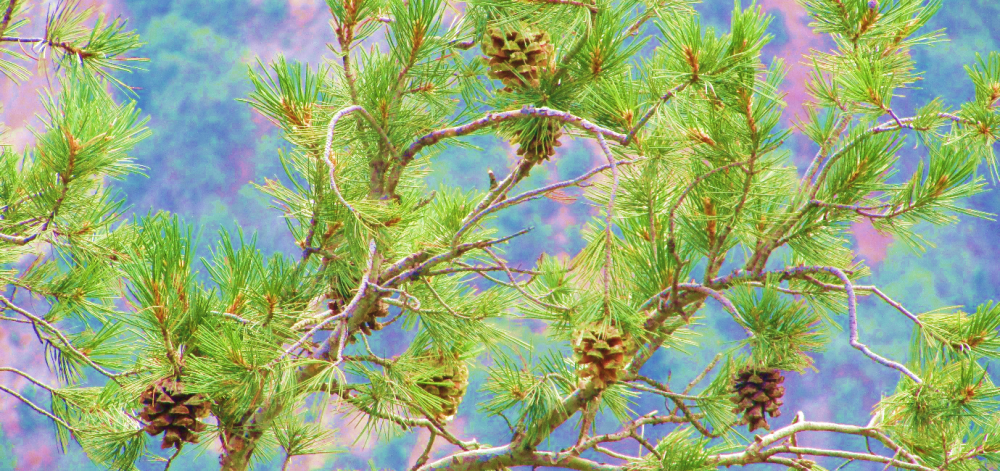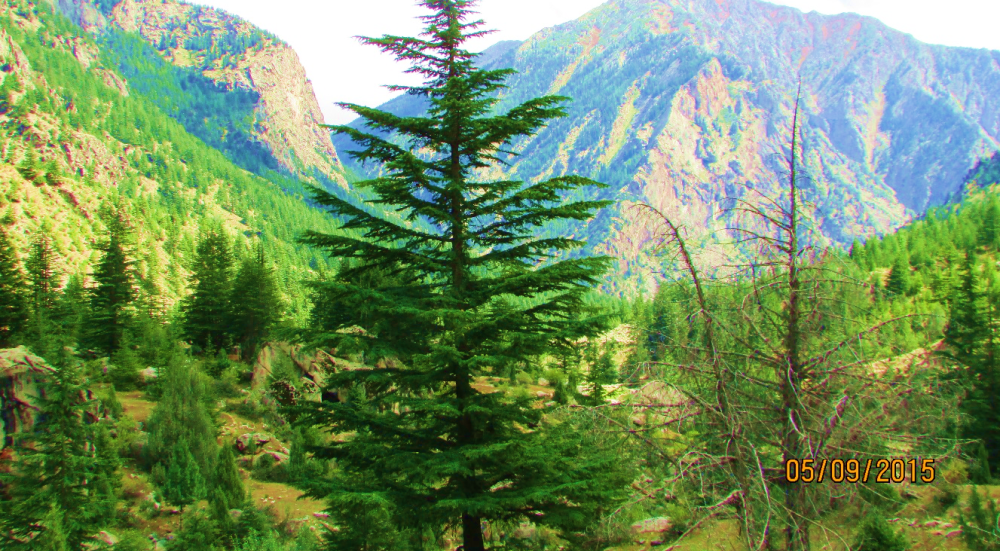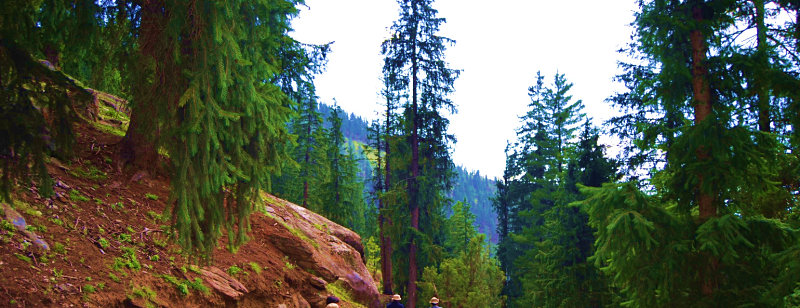
Pinus wallichiana (Pinaceae)
Home COMMON NAMES: Kail, Biar, Blue pine Local name: Chee, Gashi Description Tree to 50+ m tall with a straight trunk and short, downcurved
Forest, Wildlife & Environment Department Government of Gilgit-Baltistan
Biophysical context
Gilgit-Baltistan (GB) is located in extreme north of Pakistan beyond the effective reach of monsoon rains (between 35-37°N and 72-75°E) amidst Himalayas, Karakoram, Hindukush & Pamir mountain ranges. GB has a total geographical area of 7.04 million hectares, dominated by mountains (34%) and natural rangelands (46%), and followed by natural forest (3.58%). Cultivated agriculture lands, farm forests, cultivable waste and uncultivated waste constitute 10% geographical area (GBFD, 2016). Currently GB has an estimated population of 1.8 million with a low density of 25 person /km². With a meagre average of 0.10 ha per person agriculture land holdings scattered around 650 villages, dependency on natural resources still stands high (GOP, 2019). Based on ecological zonation five main types of forests exist in Gilgit-Baltistan, namely, Mountain Sub-Tropical Scrub, Mountain Dry Temperate Coniferous, Mountain Dry Temperate Broadleaved, Sub-Alpine and Northern Dry Scrub.
The landscape of the proposed program areas is predominantly dominated by some of the world’s highest mountains, with several peaks over 8,000 meters. Separating the mountains are a number of narrow valleys carved by rivers and streams (including the Indus and its tributaries). Much of the area lies in a rain shadow, receiving less than 200 mm of rain annually, though higher elevations may receive up to 2,000 mm of snowfall each year. Snow melt provides a permanent water source, feeding rivers and streams. Habitat types are determined by both altitudinal and climatic factors, in turn influencing the distribution of plants and animals. The main habitats include the Dry Alpine and Permanent Snowfield Zone, the Himalayan Alpine Zone, and Dry Temperate Coniferous Forests
Biodiversity
Gilgit-Baltistan is rich in biological diversity due to the extreme altitudinal differences and associated changes in climate, soil conditions and variation in aspects and exposure of slopes to solar radiation. A number of globally significant species of mammals are found in the area including some of the endangered species like the snow leopard, Himalayan brown bear, Marco Polo Sheep, Ladakh urial, flare horned Markhor, musk deer, and woolly flying squirrel. Similarly, a number of plant species of great economic and conservation values found in the area, including wild cumin, thyme, pine nuts and several other species of medicinal values. Keeping in view the significance of the flora and fauna 05 national Parks, 02 Wildlife sanctuaries, 04 Game reserves and 48 Community Controlled Hunting Areas (CCHA) have been created in Gilgit-Baltistan to protect biological resources of the region.
Forest
Pakistan has about 4.1 percent of area under forests, a considerable portion of which falls in non-productive category and unfit for commercial exploitation, except for meeting petty domestic requirements of connectionists living in the vicinity of forest habitats. Gilgit-Baltistan possesses almost the same ratio of forest resources. The district-wise proportion of forest resources in Gilgit-Baltistan however, greatly differ i.e. Diamer (30%), Astore (12%), Gilgit (0.5%), Skardu (< 0.5%) and Ghanche (< 0.3%). The farm-forestry component under community sector is 0.66 %, which is a fairly uniform figure for all districts in Gilgit-Baltistan. Since the region falls in a rain shadow area, beyond the effective reaches of Monsoon rainfalls in the inner Himalayas, the region serves as a cold desert with extreme climatic conditions. These extreme climatic conditions restrict the spread of forests, in contrast to the moist temperate forests situated in outer Himalayas. The natural forests in GB covers an area of 2492.05 sq km (3.58% of the total land), which falls under two broad categories, viz., Private Forests and State-owned Protected Forests. The Private Forests, which forms the bulk of the forest resources in GB (71% of the total forest wealth) are privately owned forests, regulated and managed by the Department in accordance with the Accession Deed 1952 and Gilgit-Baltistan Forest Act 2019. All the forest in Diamer District are Private Forests. The stated owned Forests, found across Gilgit-Baltistan except Diamer District are Protected Forests, where Government has the proprietary rights, and local resident communities have certain rights and concessions admissible under the law. These forests are over all classified as Himalayan dry temperate forests. However on higher elevations, sub-alpine forests and alpine scrub lands/forests are also found. In lower reaches of GB along indus from Sumar nala to Bunji Area, small patches of sub-tropical dry scrub vegetation is found.
Gilgit-Baltistan has an agro-silvi-pastural economy, being practice since centauries. Locals practice farm forestry for subsistence living for cooking purpose, and specially for heating purpose during the harsh and chilling winter months. The department, during 1950’s and 1960’s established a number of forest plantations along river beds, marginal lands and state properties to incentivize and subsidize the general public for production of timber and fire wood with a view to decrease pressure on natural forests, soil conservation measures and public service in its capacity as a national building department. This centauries old practice of farm forestry got momentum and significant boost with the inception of AKRSP in 1980’s. Realizing the importance of farm and social forestry, Gilgit-Baltistan, Forest Department has also emphasized for promotion of social forestry through establishment of great numbers of Government owned and Private nurseries, and through different incentive mechanisms to accelerate the pace of development of social and farm forestry. Currently the Department owns 66 numbers of Government plantations and 56 nurseries across GB.

Home COMMON NAMES: Kail, Biar, Blue pine Local name: Chee, Gashi Description Tree to 50+ m tall with a straight trunk and short, downcurved

Home Common name: Chilghoza pineLocal Name: Chalghoza, Thulash Description: Trees 10-20(25) m tall. Crown is usually deep, wide and open with long, erect branches, but

Home Common name: Diar, Deodar, Himalayan Cedar Local name: Diar, Phulus Description: “A tree up to 50 m high and up to 3 m in

Home Common name: Partal, Silver Fir. Local name: Qachul Description: Trees to 60 m tall and 300 cm DBH, typically with a single straight, round
Forest, Wildlife & Environment Department Government of Gilgit-Baltistan
We firmly believe that the internet should be available and accessible to anyone, and are committed to providing a website that is accessible to the widest possible audience, regardless of circumstance and ability.
To fulfill this, we aim to adhere as strictly as possible to the World Wide Web Consortium’s (W3C) Web Content Accessibility Guidelines 2.1 (WCAG 2.1) at the AA level. These guidelines explain how to make web content accessible to people with a wide array of disabilities. Complying with those guidelines helps us ensure that the website is accessible to all people: blind people, people with motor impairments, visual impairment, cognitive disabilities, and more.
This website utilizes various technologies that are meant to make it as accessible as possible at all times. We utilize an accessibility interface that allows persons with specific disabilities to adjust the website’s UI (user interface) and design it to their personal needs.
Additionally, the website utilizes an AI-based application that runs in the background and optimizes its accessibility level constantly. This application remediates the website’s HTML, adapts Its functionality and behavior for screen-readers used by the blind users, and for keyboard functions used by individuals with motor impairments.
If you’ve found a malfunction or have ideas for improvement, we’ll be happy to hear from you. You can reach out to the website’s operators by using the following email
Our website implements the ARIA attributes (Accessible Rich Internet Applications) technique, alongside various different behavioral changes, to ensure blind users visiting with screen-readers are able to read, comprehend, and enjoy the website’s functions. As soon as a user with a screen-reader enters your site, they immediately receive a prompt to enter the Screen-Reader Profile so they can browse and operate your site effectively. Here’s how our website covers some of the most important screen-reader requirements, alongside console screenshots of code examples:
Screen-reader optimization: we run a background process that learns the website’s components from top to bottom, to ensure ongoing compliance even when updating the website. In this process, we provide screen-readers with meaningful data using the ARIA set of attributes. For example, we provide accurate form labels; descriptions for actionable icons (social media icons, search icons, cart icons, etc.); validation guidance for form inputs; element roles such as buttons, menus, modal dialogues (popups), and others. Additionally, the background process scans all the website’s images and provides an accurate and meaningful image-object-recognition-based description as an ALT (alternate text) tag for images that are not described. It will also extract texts that are embedded within the image, using an OCR (optical character recognition) technology. To turn on screen-reader adjustments at any time, users need only to press the Alt+1 keyboard combination. Screen-reader users also get automatic announcements to turn the Screen-reader mode on as soon as they enter the website.
These adjustments are compatible with all popular screen readers, including JAWS and NVDA.
Keyboard navigation optimization: The background process also adjusts the website’s HTML, and adds various behaviors using JavaScript code to make the website operable by the keyboard. This includes the ability to navigate the website using the Tab and Shift+Tab keys, operate dropdowns with the arrow keys, close them with Esc, trigger buttons and links using the Enter key, navigate between radio and checkbox elements using the arrow keys, and fill them in with the Spacebar or Enter key.Additionally, keyboard users will find quick-navigation and content-skip menus, available at any time by clicking Alt+1, or as the first elements of the site while navigating with the keyboard. The background process also handles triggered popups by moving the keyboard focus towards them as soon as they appear, and not allow the focus drift outside it.
Users can also use shortcuts such as “M” (menus), “H” (headings), “F” (forms), “B” (buttons), and “G” (graphics) to jump to specific elements.
We aim to support the widest array of browsers and assistive technologies as possible, so our users can choose the best fitting tools for them, with as few limitations as possible. Therefore, we have worked very hard to be able to support all major systems that comprise over 95% of the user market share including Google Chrome, Mozilla Firefox, Apple Safari, Opera and Microsoft Edge, JAWS and NVDA (screen readers).
Despite our very best efforts to allow anybody to adjust the website to their needs. There may still be pages or sections that are not fully accessible, are in the process of becoming accessible, or are lacking an adequate technological solution to make them accessible. Still, we are continually improving our accessibility, adding, updating and improving its options and features, and developing and adopting new technologies. All this is meant to reach the optimal level of accessibility, following technological advancements. For any assistance, please reach out to